Saturday, April 17, 2004
"similar difficulties could arise over valuable stamps and other items"
Silvered Æ antoninianus, Rome, Gallienus, Göbl 549gvar
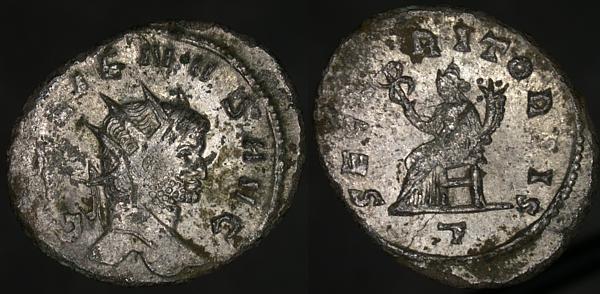
IMP GALLIENVS AVG, Radiate head right | SECVRIT ORBIS, Felicitas seated left, holding overflowing cornucopia right and cauduceus left. T in exergue.
An interesting error: with this reverse legend the figure should be Securitas, with her left hand to her hair and her right holding a scepter left, like this. Instead, holding cauduceus and cornucopia, this is Felicitas, as on the FELICIT PVBL coins.
It seems reasonable to assume that these two reverses were in production simultaneously, or that FELICIT PVBL was produced immediately before SECVRIT ORBIS.
Göbl doesn't list this error, but his plates for the SECVRIT ORBIS coins do show one of these mismatches, apparently unnoticed while the book was being completed.
Curtis Clay, in FORVM's discussion area, points out that this reverse is described in Cohen. This is an encylopedia of Roman coinage, originally published 1880-1892, so this error has been published for over 100 years and I may be the first person to see that it is an error.
A minor discovery, and perhaps it's already documented somewhere obscure, but still cool for me.
Friday, April 16, 2004
Æ23, Augusta Traiana in Thrace, Gallienus, Varbanov 521
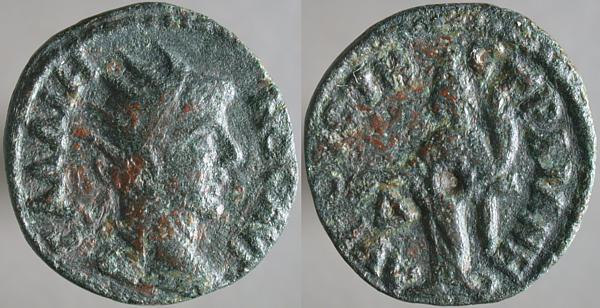
ΓΑΛΛΙΗ_ΝΟC ΑVΓ, Radiate head right | ΑVΓΟVCΤΗ_C ΤΡΑΙΑΝΗC, Homonia standing facing, head left, holding patera left and cornucopia right. Δ in left field.
A few photos of Stara Zagora, on the site of Augusta Traiana.
This was the first coin I purchased from the city of Augusta Traiana. It's a bit smaller than the others I posted this week, and the Δ on the reverse is apparently a mark of denomination: four assaria, which the others do not show. (I have one more to post on Sunday which is of this size and is also a four assaria piece.) I've seen that another example sold in Europe in May, 2001.
Until today I had no catalog listing for it, but I now have a copy of Varbanov, a four-volume Bulgarian catalog of Roman Provincial coins. It's a useful adjunct to the Western catalogs because it includes coins from areas that were controlled by the Warsaw Bloc, coins that weren't seen much in the west before the fall of the Soviet Union. While these coins are more common on the market now, Western catalogs have lagged. Varbanov, though, will be even more difficult to use than Göbl, where I can at least read the alphabet and use Google to get rough translations.
I think it's Bulgarian.
Thursday, April 15, 2004
Æ denarius, Rome, Gallienus, Göbl 582bbvar
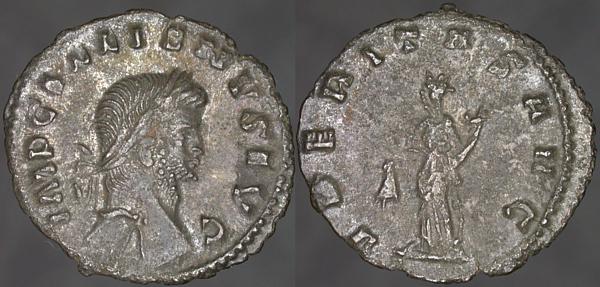
IMP GALLIENVS AVG, Laureate head right | VBERITAS AVG, Uberitas standing left holding marsupium left and cornucopia right.
Uberitas was the personification of fruitfulness, primarily agricultural fertility, as seen in her cornucopia, but extending to other things as well, so that she carries a marsupium, or pouch.
Göbl attests this denarius with the legend GALLIENVS AVG, but not that seen here, IMP GALLIENVS AVG. I believe this coin to be authentic and published in no reference.
Wednesday, April 14, 2004
Orichalchum dupondius, Rome, Galba, 68-69 CE, RIC 370
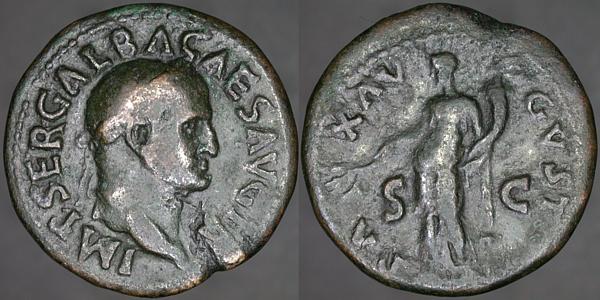
IMP SER GALBA CAES AVG T[R P], Laureate head right | PA_X AV_GVST, Pax standing facing, head left, holding olive branch left and cornucopia right. S_C across fields.
After Nero committed suicide on June 9, 68 leaving no heir, violence broke out in Rome with various factions vying for power. Servius Sulpicius Galba, a man of impeccable patrician lineage serving as proconsul in Spain, marched on Rome.
Intense maneuvering with the Senate earned him the status of Augustus but, unwilling to bend to political reality, Galba did little to cement the allegiance of the military or to limit the growing power of his opponents. When he adopted Lucius Calpurnius Piso Frugi Licinianus and named him as his heir, Galba's former ally Otho, who had assumed that he would succeed Galba, formed a conspiracy with the praetorians, themselved disaffected by Galba's refusal to bribe them with donatives. On 15 January, 69, these praetorians butchered Galba and his heir in the forum.
The dupondius, worth two ases, clearly filled a need in the Roman economy (the next most valuable coin was the sestertius, worth four ases), it could be difficult to distinguish the two. The dupondius was made of orichalchum, yellow when new, and the as of bronze, red when new.
As they aged in circulation, though, both metals tended to become chocolate brown. In most reigns, the emperor was shown wearing the radiate crown of Sol on the dupondius and a laurel wreath on the as.
Probably because he ruled immediately after Nero, whom he viewed as dangerously monarchistic, Galba wears the laurel wreath on both the as and the dupondius, and the coins must be distinguished by weight.
The reverse shows Pax, the goddess of peace, a false reassurance to the citizens of Rome who were about to see 69 CE, the year of four emperors and little by way of peace.
Tuesday, April 13, 2004
Æ25, Augusta Traiana in Thrace, Gallienus, Varbanov 519
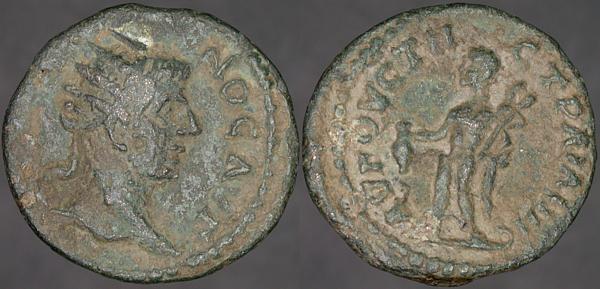
[ΓΑΛΛΙΗ]_ΝΟC ΑVΓ, Radiate head right | ΑVΓΟVCΤΗ_C ΤΡΑΙΑΝΗC, Hermes standing facing, head left, holding purse left and caduceus right.
A page about the numismatic collection at the Bulgarian National Archeological Museum.
Hermes, messenger of Zeus, swift and skilled, carries a purse to represent his status as patron of trade and, perhaps, theft.
Monday, April 12, 2004
Silvered Æ antoninianus, Antioch, Gallienus, Göbl 1634c
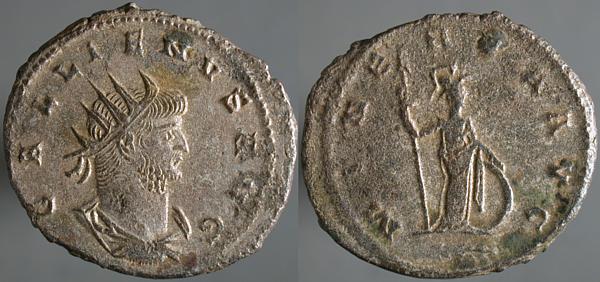
IMP GALLIENVS AVG, Radiate draped cuirassed bust right | MINERVA AVG, Minerva standing right, holding spear left and shield right. Branch in exergue.
Minerva, the Roman version of Athena, patroness of Athens, was always a popular subject for coins, and always worth propitiating. Or else.
Sunday, April 11, 2004
Æ25, Augusta Traiana in Thrace, Gallienus, Varbanov 514
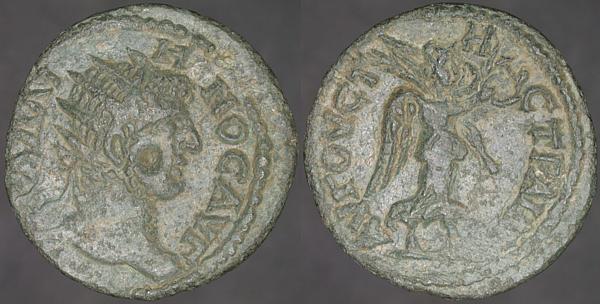
ΓΑΛΛΙ_Η_ΝΟC ΑVΓ, Radiate head right | ΑVΓΟVCΤ_Η_C ΤΡΑΙΑΝ[ΗC], Nike advancing right, holding palm over shoulder and wreath before her.
The City of Stara Zagora Information Center, located at 44, Augusta Traiana Street.
Roman Provincial coins probably feature Tyche more frequently than any other reverse design. Her niece Nike, in the form of the Roman Victoria is probably the commonest reverse design on Roman Imperial coins. Still, plenty of Imperial coins feature Fortuna, and plenty of Provincials Nike.
At this writing I have five coins from this city, and all but the one I posted Friday use this obverse legend, ΓΑΛΛΙΗΝΟC ΑVΓ, a direct transliteration of the latin GALLIENVS AVG, rather than the translation ΑVΤ ΓΑΛΛΙΗΝΟC, or similar, that would be expected on a coin of a Greek-speaking city without colony status.

